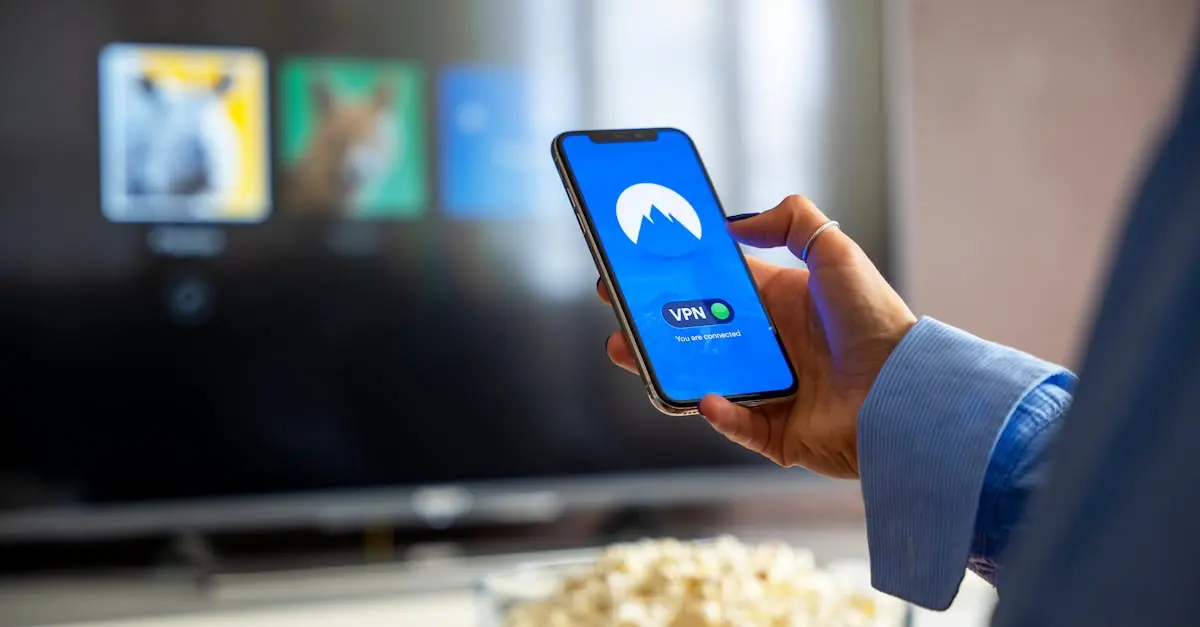Table of Contents
ToggleIn a world where binge-watching has become a competitive sport, mobile video streaming apps are the ultimate game-changers. Picture this: a cozy couch, a bowl of popcorn, and the power to stream your favorite shows right from your pocket. No more fighting over the remote or missing out on the latest episode while on the go. It’s time to embrace the future of entertainment!
Overview of Mobile Video Streaming Apps
Mobile video streaming apps revolutionized content consumption by providing instant access to a vast catalogue of movies, TV shows, and original programming. Users enjoy high-definition content on various devices, ensuring a seamless viewing experience. Popular apps like Netflix, Hulu, and Amazon Prime Video continuously expand their offerings to cater to diverse audiences.
These platforms operate under subscription-based models, granting users unlimited access to content for a monthly fee. Many also provide ad-supported options, allowing free access with occasional advertisements. Each app exhibits unique features, such as offline downloads or personalized recommendations, enhancing user engagement.
Mobile video streaming apps offer flexibility in viewing. Users can pause, rewind, or fast-forward content, adapting to their schedules. They support multiple devices, from smartphones to tablets, ensuring that users can enjoy content during commutes or while traveling.
Furthermore, data shows that mobile streaming accounts for over 50% of global video consumption, reflecting changing viewer habits. Streaming quality has improved significantly, with most apps now offering 4K resolution for select titles. Many also incorporate features like cloud DVR storage, enabling users to record live shows and access them later.
The increasing availability of high-speed mobile internet further fuels the popularity of these apps. Users can now stream content seamlessly, regardless of location. As these services continue to innovate, they remain an essential part of modern entertainment’s evolution.
Popular Mobile Video Streaming Apps
Mobile video streaming apps dominate the entertainment landscape, offering diverse options for viewing preferences. Several applications stand out for their unique functionalities.
App Features Comparison
Users benefit from a range of features across different apps. Netflix provides robust offline downloads, while Hulu grants access to live programming. Amazon Prime Video excels with its extensive library of original content. Users can personalize their recommendations on most platforms, making content discovery seamless. Some apps offer ad-supported options, allowing free access with commercial interruptions. In terms of streaming quality, several platforms support 4K resolution for select titles, which enhances viewing experiences significantly.
User Interface and Experience
A well-designed user interface greatly impacts user experience. Simple navigation is a hallmark of most popular apps, allowing users to find content efficiently. Intuitive layouts help viewers quickly locate their favorite shows and movies. Similarly, customized playlists and watch lists improve the browsing experience across services. Each app maintains unique themes, but they prioritize user engagement through streamlined interactions. Mobile streaming apps consistently refine their interfaces to adapt to user preferences, encouraging prolonged usage.
Performance and Quality
Performance and quality significantly impact user experience in mobile video streaming apps. Users prioritize uninterrupted access to high-quality content while on the go.
Streaming Speed and Buffering
Streaming speed heavily influences user satisfaction. Users expect minimal buffering during playback. Many apps utilize adaptive streaming technology, automatically adjusting video quality based on internet speed. This feature ensures seamless viewing with minimal interruptions. According to recent studies, over 60% of users abandon streams that buffer frequently. High-speed connections are crucial, as mobile networks now support faster download speeds, reducing loading times considerably. Creative algorithms analyze buffering incidents, allowing apps to switch to lower resolutions momentarily when connectivity falters.
Video Resolution and Clarity
Video resolution plays a vital role in overall clarity and user engagement. Many streaming platforms now offer content in 4K resolution, enhancing the viewing experience dramatically. Users appreciate sharp details, vibrant colors, and crisp image quality. Studies show that viewers often prefer higher resolutions, correlating with longer watch times and increased subscriptions. Some apps allow users to select their desired resolution, balancing quality against potential data usage. As mobile technology advances, improvements in video clarity continue to shape user expectations, driving competition among platforms to deliver superior content.
Subscription Models and Pricing
Mobile video streaming apps adopt various subscription models that cater to diverse user preferences. These models often determine the accessibility and quality of content.
Free vs. Paid Apps
Free apps typically offer a limited selection of content, often supported by ads. Watching shows on these platforms may come with interruptions, which can affect the viewing experience. In contrast, paid apps provide unlimited access to a vast library of high-quality content, generally without advertisements. Monthly fees for subscriptions range from $5 to $20, depending on the platform and services offered. Users who prefer a seamless experience often gravitate towards these paid options, valuing the absence of ads in exchange for their investment.
In-App Purchases and Ads
Many streaming platforms implement in-app purchases alongside subscription services. Users may encounter additional fees for premium content or exclusive releases. Ads also play a significant role in free and lower-tier subscription levels, generating revenue while minimizing user costs. Research indicates that over 70% of viewers tolerate ads when presented with free access to content. Balancing advertisement frequency against available features becomes crucial for maintaining user satisfaction. Users tend to prefer platforms that minimize ad interruptions while providing valuable content.
Conclusion
Mobile video streaming apps have undeniably reshaped how people consume entertainment. With their ability to deliver vast libraries of content right to users’ fingertips, these platforms cater to the demands of today’s fast-paced lifestyle.
As technology continues to advance, the competition among streaming services will likely intensify, pushing them to innovate and enhance user experiences. Features like offline downloads and personalized recommendations are just the beginning of what users can expect.
The future of mobile video streaming looks bright, as it adapts to meet the evolving preferences of viewers. As more people embrace this convenient way to watch their favorite shows and movies, it’s clear that mobile streaming is here to stay.





